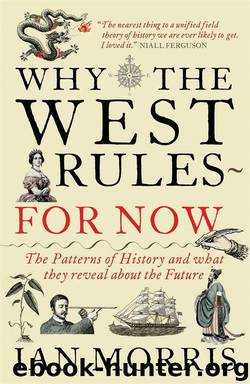Why the West Rules--For Now: The Patterns of History, and What They Reveal About the Future by Ian Morris

Author:Ian Morris [Morris, Ian]
Language: eng
Format: mobi, epub
Tags: General History, History
ISBN: 9780374290023
Publisher: Macmillan
Published: 2010-10-11T10:00:00+00:00
DIFFERENT RIVERS
History looked to be repeating itself. In the first century CE Western social development had risen to a hard ceiling around forty-three points, strained against it, and set off a centuries-long, Old World–wide collapse. Eleven hundred years later, Eastern social development rose to the same level and set off similar disasters. Had von Däniken’s aliens from outer space been orbiting Earth again in 1350 they might well have concluded that human history was locked in a series of boom-and-bust cycles, bouncing against an unbreakable hard ceiling.
But like all the spacemen I have imagined so far, they would have been mistaken, because another historical law was also operating. I commented earlier that not even Genghis Khan could step into the same river twice; and neither could the horsemen of the apocalypse. The cores across which the horsemen rode during the Second Old World Exchange were very different from those they had devastated during the First Old World Exchange, which meant that the Second Exchange had very different consequences from the First.
Most obviously, both cores were geographically bigger when the Second Exchange intensified around 1200 than they had been during the First (Figure 8.5), and size mattered. On the one hand, larger cores generated larger disruptions: it is hard to quantify calamity, but the plagues, famines, and migrations that began in the thirteenth century do seem to have been even worse than those that began in the second century. On the other hand, though, larger cores also meant greater depth to absorb shocks and larger reserves to hasten recovery. Japan, Southeast Asia, the Mediterranean Basin, and most of Europe escaped Mongol devastation in the thirteenth century; Japan and Southeast Asia avoided the Black Death in the fourteenth too; and in the very heart of China the Yangzi Delta region seems to have come through the disasters remarkably well.
Economic geography had also changed. Around 100 CE the Western core was richer and more developed than the Eastern, but by 1200 the reverse was true. It was the Eastern core, not the Western, that was now straining against the hard ceiling, and Eastern commercial networks (especially those linking southern China, Southeast Asia, and the Indian Ocean) dwarfed anything in the West.
Download
Why the West Rules--For Now: The Patterns of History, and What They Reveal About the Future by Ian Morris.epub
This site does not store any files on its server. We only index and link to content provided by other sites. Please contact the content providers to delete copyright contents if any and email us, we'll remove relevant links or contents immediately.
Cecilia; Or, Memoirs of an Heiress — Volume 1 by Fanny Burney(32437)
Cecilia; Or, Memoirs of an Heiress — Volume 2 by Fanny Burney(31873)
Cecilia; Or, Memoirs of an Heiress — Volume 3 by Fanny Burney(31857)
The Great Music City by Andrea Baker(31488)
We're Going to Need More Wine by Gabrielle Union(18972)
All the Missing Girls by Megan Miranda(15588)
Pimp by Iceberg Slim(14398)
Bombshells: Glamour Girls of a Lifetime by Sullivan Steve(13977)
Talking to Strangers by Malcolm Gladwell(13229)
Norse Mythology by Gaiman Neil(13211)
Fifty Shades Freed by E L James(13159)
For the Love of Europe by Rick Steves(13055)
Mindhunter: Inside the FBI's Elite Serial Crime Unit by John E. Douglas & Mark Olshaker(9206)
Crazy Rich Asians by Kevin Kwan(9170)
The Lost Art of Listening by Michael P. Nichols(7411)
Enlightenment Now: The Case for Reason, Science, Humanism, and Progress by Steven Pinker(7239)
The Four Agreements by Don Miguel Ruiz(6636)
Bad Blood by John Carreyrou(6557)
Weapons of Math Destruction by Cathy O'Neil(6148)
